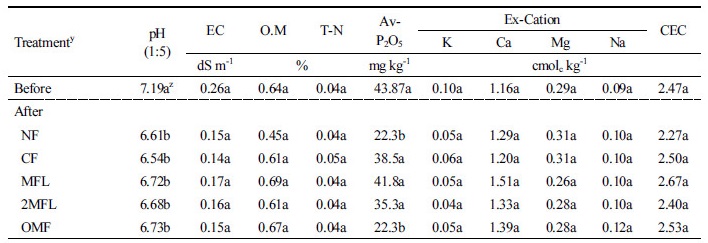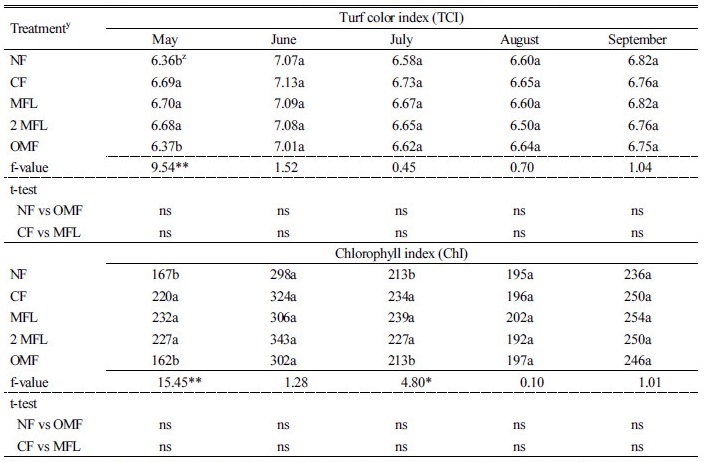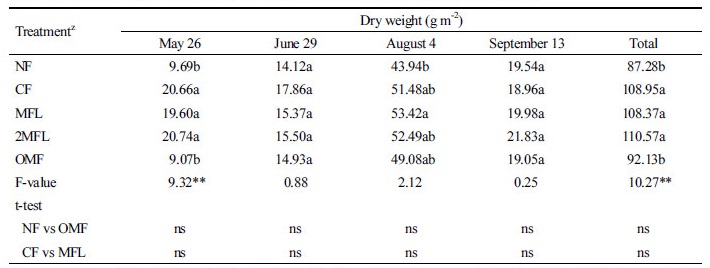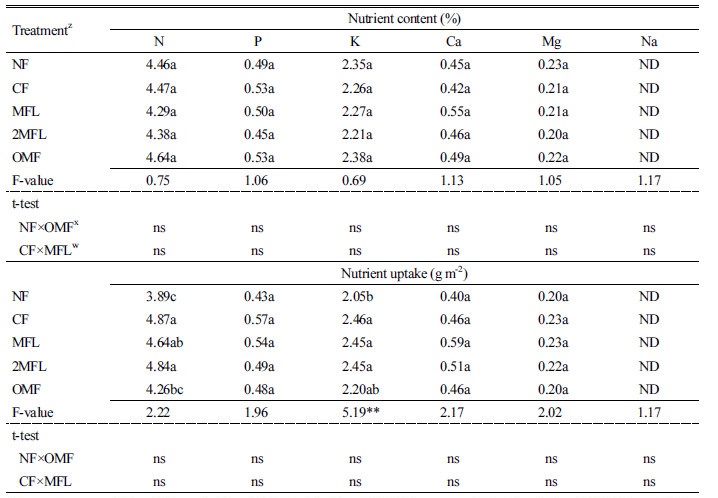서 론
잔디는 도시의 공원이나 정원의 녹지공간을 확보하고, 도로나 산림훼손지역의 토양침식을 방지하며, 스포츠 경기장이나 골프장의 피복식물로 이용하고 있다(Ahn et al., 1992; Jang et al., 2011). 잔디 이용 면적의 많은 부분을 차지하는 골프장은 잔디 재배면적, 생산량 및 생산액의 증가에 영향을 주었다(Choi and Yang, 2006; Jang et al., 2011). 2016년 한국골프장경영협회 보고에 따르면, 2000년 이후 골프장 건설은 크게 증가하였는데 2005년 운영 중이던 골프장이 224개였던 것이 2011년에는 400개로 약 2배 정도 증가하였고, 2016년 현재 483개로 5년 전보다 약 25% 증가하였다.
골프장에 식재된 잔디는 코스의 미관이나 디자인을 결정하고, 관리 정도에 따라 골프장의 경기품질이나 난이도를 결정하는 매우 중요한 요소이다(Ahn et al., 1992). 골프장의 잔디는 잦은 깎기 작업, 낮은 예고 및 답압 등으로 잔디품질을 유지하는데 많은 어려움이 있다(Lee et al., 2010). 골프장은 다른 잔디 식재지역과 달리 모래 함량이 높은 사토에서 관리되고 있어 잔디 생육에 필요한 적절한 시비 관리가 필요하다(Kweon, 2005; Kim et al., 2009). Kim et al. (2009a, b)은 완효성 질소가 포함된 비료를 시비할 때, 속효성 비료 보다 토양 중 가용성 질소 함량이 증가하여 한지형 잔디의 생육과 품질이 향상된다고 보고하였다. 이와 더불어 기능성 비료나 미생물제제의 처리는 잔디의 뿌리 생육이나 양분 흡수를 촉진하여 잔디 엽색이나 밀도를 향상시킴으로써 잔디의 생육과 품질이 좋아진다고 보고되고 있다(Kim et al., 2008b; Chang et al., 2010; Kim et al., 2010; Kim et al., 2012).
이는 미생물이 토양 중 유기물을 분해하거나 양분을 가용화하고(Lee et al., 2013), 식물생육을 촉진하는 생장호르몬을 발생하기 때문이다(Kim et al., 2011b). 그 외에도 미생물은 병원균과 길항성(Lim et al., 2011; Ma et al., 2013)을 나타낼 뿐만 아니라 저항성 물질을 생산하여 병원균의 침입을 막기 때문이다(Park et al., 2007). 이렇듯 잔디 관리에 미생물의 이용은 잔디의 생육을 촉진시키고, 병해에 대한 잔디의 저항성을 증가시켜 친환경적인 잔디 관리를 위해 중요도가 증가하고 있다(Kato, 2005).
국립농산물품질관리원 조사에 의하면 미생물제제의 유효균주로서 많이 이용되는 균주는 고초균, 유산균, 효모균 순이라고 알려져 있다. 미생물제제는 Bacillus sp.를 유효 균주로 하는 미생물제제로서 농업에서 작물의 생육과 병방제를 위해 가장 많이 연구된 미생물이다(Lim et al., 2011; Ma et al., 2013; Kim et al., 2016). 다음으로 많이 이용하고 있는 유산균은 주로 식품의 발효에 이용하고 있는 미생물로서 농업적 이용에 대한 연구가 상대적으로 적은 편이다. 특히, 유산균은 발효식품에 사용되는 안전한 미생물로서 발효식품의 맛과 특징을 결정하는 발효유, 김치, 젓갈 및 장류 등에서 분리되는데(Kim et al., 2011a; Park et al., 2013) 각종 유기산과 항균활성물질을 생성하여 식품의 저장성에 기여하여(Kim et al., 2011) 발효유를 생산하는데 있어 원유의 발효 starter로 사용된다(Leroy and De Vuyst, 2004; Park et al., 2013). 이렇듯 유산균은 주로 식품의 발효에 이용되어 저장성 증가 및 발효품질 향상에 이용되었으나(Kim et al., 2004) 최근에는 양계 농가의 생균제 원료(Kim et al., 2008a)나 하수 슬러지의 발효(Yang et al., 2008)에 이용되고 있다. 유산균을 식품의 발효 미생물 이외에 다양하게 이용하고자 하는 연구는 이뤄지고 있었으나 작물 재배나 생육에 이용한 연구는 매우 적었다. Kim et al. (2008b, 2010)은 유산균과 효모균을 포함하는 미생물제제의 처리가 잔디의 생육과 품질을 증가시킨다고 보고하였으나 복합미생물을 처리하였기 때문에 유산균의 효과를 확인하기는 어려웠다.
따라서 본 연구에서는 유산균(Lactobacillus fermentum)을 함유하는 미생물제제를 크리핑 벤트그래스에 처리하였을 때, 잔디의 생육과 품질에 미치는 영향에 대해 조사하고자 수행되었다.
재료 및 방법
시험기간 및 공시재료
본 연구는 2010년 5월부터 2010년 9월까지 5개월 동안 인천광역시 소재의 SKY72 골프클럽 증식포장에서 수행하였다. 공시잔디는 2006년 파종되어 약 5년간 관리된 크리핑 벤트그래스(Agrostis palustris H.) ‘Pennlinks’ 품종을 이용하였다. 시험포장의 토양은 USGA 규격에 적합한 모래와 코코피트가 각각 95%와 5%씩 부피로 혼합된 모래 상토로 조성되어 있었고, 상토층의 깊이는 약 15 cm였다. 잔디 생육에 필요한 양분을 공급하기 위해 공시비료는 복합비료(compound fertilizer: N-P2O5-K2O = 21-17-17, ㈜남해화학, 서울, 한국)와 식물재배용으로 개발되어 판매되는 유산균 미생물제제(L. fermentum, 1.0×107 cfu g-1, FMT Korea Co., LTD., 의정부, 한국)를 사용하였다. 유산균 미생물제제 (microbial fertilizer containing L. fermentum; MFcL)는 L. fermentum이 1.0×107 cfu g-1로 보증되어 있었고, 제형은 흰색 분말의 수용제였다.
미생물제제 처리 및 잔디 관리
처리구는 공시비료의 종류와 처리량에 따라 무처리구(non-fertilizer: NF), 대조구(control fertilizer (N-P2O5-K2O = 21-17-17; CF), MFcL 추천량 처리구(MFL; CF+MFcL)와 배량 처리구(2MFL; CF+2MFcL) 및 MFcL단독 처리구(only MFcL; OMF)로 구분하였다.
실험 포장의 실험구 단위는 3 m2 (1 m × 3 m) 크기로 전체포장은 45 m2였고, 실험구 배치는 난괴법(3반복)으로 배치하였다. 공시비료 중 복합비료는4월 29일, 5월 27일, 6월 30일, 8월 5일에 3.0 g N m-2씩 총 4회 처리하였고, MFcL은 4월 29일부터 9월 2일까지 2주 간격으로 총 10회 처리하였고, 1회 처리량은 MFL과 2MFL처리구에서 각각 MFcL 1.0 g m-2과 MFcL 2.0 g m-2을 200 mL의 수돗물에 희석하여 액상분무살포기(KS-10-1, 광성분무기, 대전, 한국)를 이용하여 경엽처리(희석액 200 mL m-2)하였다. 시험기간 중 예초 관리는 자주식 그린모어(GM262B-AC9, SIBAURA, Tokyo, Japan)로 주 2-3회 5.5 mm 높이로 실시하였다. 시험 기간 중 통기 작업과 배토는 수행하지 않았으며, 병해 방제를 위해 이프로디온 수화제(5월 19일, 6월 22일)와 테부코나졸 유제(8월 19일, 9월 4일) 를 각각 2회씩 살포하였다.
생육 조사 및 분석 방법
잔디 생육 조사는 처리구별 엽색 지수, 엽록소 지수, 잔디 예지물량, 잔디 밀도 및 잔디 무기 성분을 조사하였다. 엽색 지수와 엽록소 지수는 각각 Turf color meter (TCM 500, Spectrum Technologies, Inc., Plainfied, IL, USA)와 Chlorophyll meter (CM 1000, Spectrum Technologies, Inc., Plainfied, IL, USA)를 이용하여 측정하였다. 조사는 5월 6일부터 7-10일 간격으로 총 18회 측정하였으며, 조사 결과는 월별 평균을 통해 나타내었다. 예지물 조사는 5월 26일, 6월 29일, 8월 4일, 9월 13일에 총 4회 수행하였고, 수확된 잔디를 70°C 드라이오븐[VS-1203PJ-300, (주)비전과학, 부천, 한국]에서 24시간 건조한 후 건물중을 측정하였다. 잔디 밀도의 변화를 측정하기 위해 제작한 밀도 측정용 코어(1 cm × 1 cm; 1 cm2)를 이용하여 시험 종료일인 9월 15일에 시료를 3개씩 채취하여 줄기 개수를 실측하여 조사하였다. 시험기간 중 기상의 변화는 기상청의 자료를 이용하였다.
포장시험에서 공시비료 처리에 의한 토양 화학성 변화를 조사하기 위해 시험 전(4월 25일)과 시험 종료 후(9월 15일) 총 2회 실시하였다. 토양시료는 자체 제작된 토양시료 채취용 코어(지름 2 cm, 깊이 10 cm)를 이용하여 각 처리구별 4개씩 토양시료를 채취하였고, 분석을 위해 음지에서 풍건하였다. 분석 항목은 pH, 전기전도도(electrical conductivity; EC), 유기물(organic matter; O.M) 함량, 전질소(total nitrogen; T-N), 유효인산(available phosphate; Av-P2O5), 치환성 양이온(exchangeable cation; K, Ca, Mg, Na) 및 양이온 치환용량(cation exchangeable capacity; CEC) 등 이다. 분석 방법은 토양 화학 분석법(NIAST, 1998)에 준하여 실시하였으며, pH와 EC는 1:5법으로, O.M은 Tyurin법으로, T-N은 Kjeldahl 증류법으로, Av-P2O5는 Bray No1법으로, 치환성 양이온과 CEC는 1N-NH4OAc침출법으로 각각 분석하였다. 식물체 분석은 시험 종료 시기인 9월 13일 채취된 잔디 예지물을 건조하여 분석시료로 이용하였다. 분석 영양소는 잔디 생육의 주요 구성 성분인 질소, 인, 칼륨, 칼슘, 마그네슘 및 나트륨 등을 포함하였다. 잔디 식물체 분석은 식물체 분석법(NIAST, 1998)에 준하여 실시하였고, 질소는 Kjeldahl 증류법으로, 인은 UV-spectrophotometer (U-2800, Hitachi, Tokyo, Japan)를 이용하여 바나도몰리브덴산법으로 정량하였다. 그밖에 칼륨, 칼슘, 마그네슘 및 나트륨은 질산 분해 후 유도 결합 플라즈마[inductively coupled plasma (ICP); Integra XL, GBC, Victoria, Australia]를 이용하여 각각 분석하였다. 양분 흡수량는 건물중과 잔디 조직 분석 결과를 이용하여 아래 식과 같이 조사하였다(Kim et al., 2001).
양분 흡수량(g m-2) = 건물중(g m-2) × 잔디 중 양분 함량(%)
통계처리는 SPSS 12.1.1 (IBM, USA)을 이용하여 Duncan 다중검정을 통해 처리구간 평균값의 유의차를 검정하였다.
결과 및 고찰
토양의 무기 성분 함량
시험 전 토양은 pH와 EC가 각각 7.19과 0.26 dS m-1로 잔디재배가 가능한 토양이었다. 시험 전과 후의 토양 화학성 분석결과, pH는 시험 전보다 낮아졌고, 유효인산은 무처리구(NF)와 미생물제제 단독처리구(OMF)에서만 감소하였고, 다른 지표들은 처리구별 차이를 나타내지 않았다(Table 1). 시험 종료 후 모든 처리구의 pH가 감소한 것으로 보아 미생물제제의 처리에 의한 변화가 아니라 시험 기간 동안 재배시험 지역의 환경의 변화에 의해 나타난 것으로 판단된다(Jeon et al., 2007). 시험 종료 후 처리구별 토양 화학성의 변화는 NF와 OMF 처리구에서 유효인산 함량의 감소가 크게 나타났으나 CF, MFL 및 2MFL에는 시험 전과 시험 후의 유효인산 함량은 통계적으로 유의차를 보이지 않았다. 또한 유효인산을 제외한 pH, EC, 치환성 양이온과 CEC 및 유기물 함량이나 전질소와 같은 토양 화학성 지표는 처리구별 차이를 보이지 않았다(Table 1). NF와 OMF의 유의차를 분석한 결과, 처리구별 차이가 없어서 OMF 단독처리가 토양 화학성에 미치는 영향이 적은 것을 확인하였다. 대조구(CF)와 MFcL 추천량 처리구(MFL)의 비교에서도 처리구별 유의차를 확인할 수 없었다. 또한, MFcL의 처리량에 따른 추천량(MFL)과 추천배량(2MFL)의 비교에서도 비슷하였다. 이들 결과를 종합할 때, 유산균 미생물제제(MFcL)의 처리는 골프코스의 토양 화학성 변화에 미치는 영향은 미미한 것으로 나타났다.
잔디 품질 조사
유산균 미생물제제(MFcL)의 처리에 따른 크리핑 벤트그래스의 품질 변화를 확인하기 위하여 엽색 지수, 엽록소 지수 및 잔디 밀도 등을 조사하였다.
시험기간 중 온도, 강우량 및 일조시간 등의 기상조건을 조사한 결과, 온도는 8월까지 증가 후 감소하는 경향을 보였고, 강우량은 5월부터 점차 증가하여 8월과 9월에는 450 mm 이상을 나타내었으며, 강우량과 일조시간은 반비례하였다(Table 2).
MFcL 처리 후 잔디의 엽색 지수(turf color index; TCI)와 엽록소 지수(chlorophyll index; ChI)의 변화는 6월까지는 증가하였고, 7월과 8월에는 감소하였으며, 9월에 다시 증가하는 경향을 나타내었다(Table 3). 이는 한지형 잔디의 생육적온은 15.5-24.0°C 정도로 (Ahn et al., 1992) 시험기간 중 5월, 6월, 9월의 평균기온이 16.1-22.1°C로 크리핑 벤트그래스의 생육에 무리가 없는 기상조건을 보여주었다. 7월과 8월의 평균기온은 24.7-26.1°C로 생육적온보다 다소 높았으며, 5-6월에 비해 기온이 더 올라간 7-9월에는 강우가 증가하고 그에 따른 일조시간의 감소와 제한적인 시비로 인하여 생육환경이 불량하여 잔디의 엽색이 감소한 것으로 판단된다(Table 3). 처리구별 TCI와 ChI의 처리구별 변화는 5월 조사에서 NF와 OMF는 다른 처리구보다 낮게 조사되어 OMF가 무처리구(NF)와 마찬가지로 엽색 지수와 엽록소 지수에 미치는 영향이 없음을 확인하였다. 그러나 시험이 진행된 6-9월 조사에서는 대부분의 처리구에서 통계적인 유의성을 또한 보이지 않아 유산균 미생물제제의 처리가 잔디의 엽색 지수와 엽록소 지수에 미치는 영향이 적음을 확인하였다.
Table 2. Monthly air temperature of mean, minimum, and maximum, rain fall, and daylight hour recorded from May to September at Inchoen in 2010.

|

Fig. 1.
The turfgrass shoot density of creeping bentgrass in the experiment. Turfgrass shoot density was investigated on September 15 in 2010.
zTreatments were as follows. NF: non-fertilizer; CF: Control fertilizer; MFL: CF+ recommendation dose of microbial fertilizer containing Lactobacillus fermentum (MFcL 1.0 g m-2); 2MFL: CF+double dose of MFcL (MFcL 2.0 g m-2); OMF: Applied only MFcL (MFcL 1.0 g m-2). CF was applied at 3.0 g N m-2 rate on April 30, May 27, June 30, and August 5. MFL and 2MFL were applied at 0.26 g m-2 and 0.52 g m-2 rate, respectively, on April 29, May 13, May 27, June 10, June 24, July 8, July 22, August 5, August 19, and September 2.
* and ** represent significant at the 0.05 and 0.01 probability level by t-test, respectively.
MFcL의 처리 후 잔디 밀도를 조사한 결과는 Fig. 1과 같다. NF와 CF는 23.2 ea cm-2와 24.0 ea cm-2였고, MFL, 2 MFL 및 OMF의 잔디 밀도는 28.8 ea cm-2, 29.3 ea cm-2 및 28.3 ea cm-2로 조사되어 엽색 지수나 엽록소 지수의 결과와는 다르게 MFcL 처리구에서 통계적으로 유의성 있게 증가하여 MFcL 처리가 크리핑벤트그래스의 밀도를 증가시켜주는 것을 확인하였다. MFcL의 처리에 의한 잔디 밀도의 변화를 비교하기 위해 NF와 OMF를 비교하고, CF와 MFL을 비교한 결과, 두 처리 모두에서 MFcL을 처리할 때, 잔디 밀도가 증가하는 결과를 보인 것으로 보아 유산균 미생물제제의 처리 시 더운 여름 기간 분리한 생육환경으로 인하여 생육이 불량해진 크리핑 벤트그래스가 회복하는데 일부 도움이 되는 것으로 판단된다.
잔디 예지물 조사
MFcL 처리에 따른 잔디 총 예지물량은 90.1-110.6 g m-2의 범위로 조사되었다(Table 4). 5월 26일, 6월 29일 및 8월 4일 조사에서 NF와 OMF의 예지물은 적었고, 비료가 포함된 CF, MFL 및 2MFL에서는 예지물이 증가하였다. 마지막 9월 13일 조사에서는 모든 처리구에서 통계적으로 유의적인 차이를 나타내지 않았다. 시험 기간 중 총 예지물량은 NF나 OMF보다는 양분이 공급된 CF, MFL 및 2MFL에서 예지물이 증가하여 예지물의 증가는 MFcL보다는 복합비료에 의해 영향을 받는 것으로 판단되었다. 처리구간 MFcL의 처리에 따른 잔디 생육을 평가하기 위해 NF와 OMF 혹은 CF와 MFL의 t-검정을 실시한 결과, 두 비교 모두 처리구간 전 시기에서 유의성 있는 차이를 보이지 않았으며, 또한 MFcL의 처리량에 따른 잔디 예지물의 차이는 없는 것으로 판단되었다. Kim et al. (2010)의 시험에서도 미생물제제의 공급은 잔디 지하부 발달이나 양분 흡수를 증대시키기는 하나 예지물 증가에 영향을 주지 않는 것으로 보고한 바 있다. 또한 Kim et al. (2016)은 미생물을 함유한 복합비료를 잔디에 시비할 때도 잔디의 밀도나 뿌리 길이 등은 증가하나 예지물은 비슷한 결과를 보여 본 시험과 유사한 결과를 나타내었다.
잔디 조직의 무기 성분 함량 및 흡수량
잔디 중 함유된 무기 성분 함량 조사결과, 질소, 인 및 칼륨은 각각 4.29-4.64%, 0.45-0.56%, 2.21-2.38%의 범위를 나타내었고, 미생물제제 처리에 따른 크리핑 벤트그래스 조식 안에 무기성분의 함량은 통계적으로 유의성 있는 차이를 보이지 않았다(Table 5). NF와 OMF의 비교나 CF와 MFL의 비교에서도 MFcL의 처리에 따른 처리구별 차이를 나타내지 않았다.
잔디가 흡수한 처리구별 양분 함량을 조사한 결과, 질소, 인 및 칼륨의 흡수량은 각각 3.89-4.87 g m-2, 0.43-0.61 g m-2, 2.05-2.46 g m-2으로 나타났다(Table 5). NF와 OMF를 비교하거나 CF와 MF를 비교할 때, 처리구간 통계적 유의차를 나타내지 않아 MFcL의 처리 효과는 확인 할 수 없었다.
Kim et al. (2008b)은 유산균 및 효모균의 처리가 잔디의 생육이나 품질에 영향을 주어 촉진한다고 보고하였고, Kim et al. (2010)은 유산균 및 효모균 처리구에서 잔디 조직 내 질소 함량이 증가한다고 보고하였다. Lee et al. (2015)은 미생물의 처리가 잔디 생육이나 품질 개선에 필요한 양분을 직접적으로 공급하는 것은 아니며, 미생물에서 생성하는 IAA의 영향으로 잔디 예지물의 생산이 증가하여 잔디의 질소 흡수가 증대된다고 보고하였다. 잔디의 질소 흡수의 증가는 잔디 생육에 필요한 양분인 인과 칼륨의 흡수를 촉진하여 잔디품질이 개선되는 것으로 알려져 있다(Kussow et al., 2012). IAA를 생성하는 미생물의 처리는 식물의 지상부 생육을 증가시키고(Hong et al., 2015), 크리핑 벤트그래스의 잔디 밀도를 증가시키는 것으로 알려져 있다(Kim et al., 2016). 본 연구의 Table 5에서 MFcL의 처리가 질소의 흡수가 통계적으로 유의미한 차이를 나타내지는 않았으나 MFcL 처리구에서 잔디 조직 내 질소 함량이나 질소의 흡수량이 증가하는 경향을 보여 크리핑 벤트그래스의 잔디 밀도개선에 영향을 준 것으로 판단된다. MFcL이 유산균이 유효 균주인 미생물제제라는 점을 고려할 때, 크리핑 벤트그래스의 밀도가 개선된 것은 L. fermentum의 영향으로 추정된다. Lactobacillus spp.는 다양한 온도나 pH와 같은 환경 조건에서 생육이 가능하며(Kim et al., 2003), amylase와 protease와 같은 유기물 분해효소 활성이 높고(Yoo et al., 1999), 다양한 항균물질이나 단백질 등을 생성하는 것으로 알려져 있어(Cho et al., 2000) 미생물이 생성한 대사물질이나 효소활성으로 식물의 생육이나 품질이 개선되는 것으로 알려져 있다(Kim and Moon, 1986). 그러나 Lactobacillus spp.는 유제품을 생산하는데 있어 발효를 개선하고, 기능성을 향상시키는 연구가 주를 이루고 있고(Han et al., 2015), 농업에서는 가금류 사육에서 생균제로 이용하고자 하는 연구(Kim et al., 2002)가 있었으나 식물의 재배나 잔디 관리에서 많이 이용되는 미생물제제임(Kim et al., 2010)에도 불구하고 이에 대한 미생물학적 특성에 관한 연구는 거의 이뤄지지 않아 앞으로 이에 대한 후속 연구가 요구된다.






